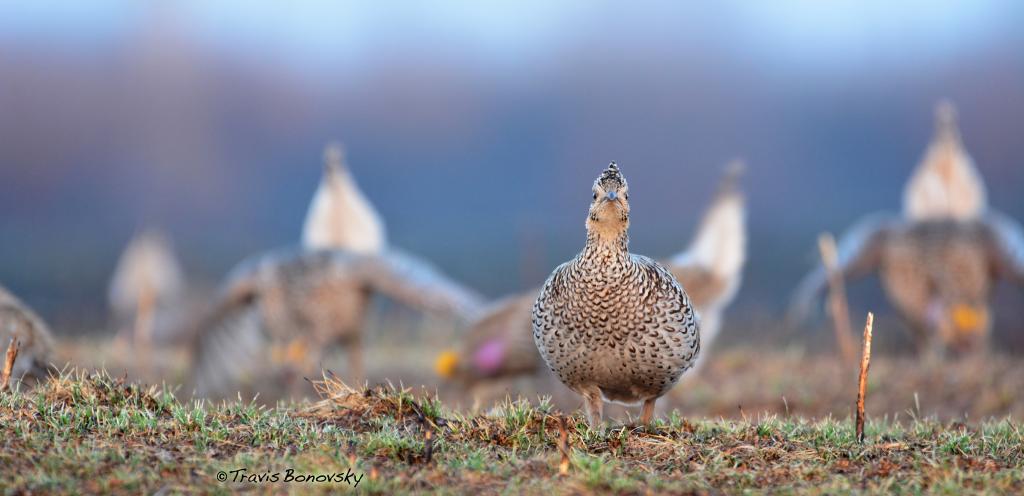Sharp-tailed Grouse Management
Sharp-tailed grouse are a resident game bird in Wisconsin. They heavily depend on young, open pine, oak barren and savanna ecosystems. Historically, sharp-tailed grouse were found throughout the state. However, due to habitat loss and fragmentation, most are now found in the northwest.
Sharp-tailed grouse populations began declining across North America, including in Wisconsin, since the early 1900s. Sharp-tailed grouse management began in Wisconsin during the late 1940s and early 1950s in response to concerns about habitat loss. Today, the DNR and several partner groups are working to restore and preserve the habitat necessary for sharp-tailed grouse and other barrens-dependent species. Some larger state-owned areas focusing on sharp-tailed grouse management include Crex Meadows Wildlife Area and Namekagon Barrens Wildlife Area.
The DNR assembled two handouts for those interested in learning more about sharp-tailed grouse and their habitat:
- Sharp-tailed Grouse: A bird of disappearing landscapes
- A Bird Of The Northwest Sands Landscape Booklet
Habitat Management
Barrens Management
Pine and oak barrens are vital habitats for sharp-tailed grouse. These barrens were once widespread in Wisconsin but are now considered globally threatened. Due to land use changes and fire suppression, the barrens of northwest Wisconsin currently exist in scattered fragments, surrounded by a forested landscape. Habitat fragmentation can threaten the long-term viability of species that depend on this ecosystem, like the sharp-tailed grouse.
The DNR uses the Northwest Sands Habitat Corridor Plan to combat habitat fragmentation by identifying and restoring habitat corridors between existing barren patches in the Northwest Sands' ecological landscape. The goal is to create a non-fragmented landscape that could benefit sharp-tailed grouse and other barren-dependent species.
Surveys
Spring Lek Surveys
Each spring, surveys for sharp-tailed grouse are conducted on dancing grounds, also known as leks. Leks are a communal display area where males gather to attract and mate with females. Male sharp-tailed grouse have a unique mating display consisting of rapid stepping motions with their tail pointed upward and wings outstretched.
Surveyors locate leks and count the number of birds present using flush surveys or observation blinds. Lek survey data and past harvest rates are considered when determining each year's population size (and harvest quota when applicable).
Sharp-tailed Grouse Observation Study
Now Available for Smartphones
Sharp-tailed grouse are now on the ArcGIS Survey123 app available for Wisconsin DNR staff, cooperators and residents to collect year-round observations. The information collected will help identify changes in sharp-tailed grouse range and production. The surveys are designed to collect opportunistic observations throughout the year, particularly in late spring and summer during the brood-rearing period (when adult females are raising their young). These observation surveys do not replace the Wisconsin DNR's long-standing lek surveys.
To get started, scan the QR code below or use the direct link. The survey uses the ArcGIS Survey123 app. If you do not have it installed on your device, you'll be directed to options to download the app. Once installed, open the survey for the species for which you'd like to record an observation. The app may ask you to sign in. If you do not have an ArcGIS account, click "Continue without signing in."
At the start of each observation, users are provided with the opportunity to click on expandable fields to get information on each species, including a range map, guidance on identifying males/females/young and examples of similar species. Information collected from each observation includes the date, time, location, observer name and affiliation, dog use at the time of the observation, the total number of birds (e.g., males, females, young, unknown) and an option to attach up to three photos.
If you're out of cell signal, don't worry. Observations can be recorded offline and saved in the ArcGIS Survey123 app to be submitted later.
Reminder, if you record an observation "later on", don't forget to move the pin on the map back to the right location.
Wisconsin Sharp-tailed Grouse Management Plan
The Wisconsin Sharp-tailed Grouse Management Plan contains information on sharp-tailed grouse taxonomy, natural history, habitat requirements, population status and distribution.
The management plan also outlines how the DNR plans to manage sharp-tailed grouse. Included are the agency's management goals and strategies for ensuring the long-term viability of sharp-tailed grouse populations in Wisconsin.
Sharp-tailed Grouse Advisory Committee
The Sharp-tailed Grouse Advisory Committee is a diverse group representing government agencies, non-governmental organizations, tribal interests and conservation groups. This committee meets a handful of times a year to discuss issues relating to sharp-tailed grouse management.
In addition to providing stakeholder perspectives to the DNR, the Sharp-tailed Grouse Advisory Committee reviews data and makes recommendations on managing sharp-tailed grouse in Wisconsin, including whether the sharp-tailed grouse population can support a hunting season that year. If a hunting season is recommended, it will be formally announced by the DNR, and information on the application period and hunting season will be added to the Sharp-tailed Grouse Hunting webpage.
The committee also advises the Wildlife Policy Team on various topics, such as hunting regulations, surveys and research priorities.
Committee Meeting Minutes
- Upcoming meeting dates
- May 15, 2025 Meeting Minutes
- Feb. 6, 2025 Meeting Minutes
- Jan. 16, 2025 Meeting Minutes
- Aug. 23, 2024 Meeting Minutes
- June 5, 2024 Meeting Minutes
- June 6, 2023 Meeting Minutes
- Nov. 3, 2022 Meeting Minutes
- Oct. 7, 2022 Meeting Minutes
- June 14, 2022 Meeting Minutes
- June 8, 2021 Meeting Minutes
- June 1, 2020 Meeting Minutes
- June 13, 2019 Meeting Minutes
Lek Viewing
Sharp-tailed Grouse Viewing Opportunity
Sharp-tailed grouse, a native prairie bird, is currently found only in suitable habitats in isolated areas of the state. Similar to more extraordinary prairie chickens, sharp tails gather at grassy openings called dancing grounds or leks during the early morning hours of spring. At the dancing grounds, males court the females by spreading their wings, rapidly stomping their feet and rattling their upturned tails as they coo and gobble with beautiful purple air sacks inflated on their necks. Viewing sharp-tailed grouse dancing is an experience you will never forget.
Dancing peaks from April 15 to May 15, depending on the year. Wildlife management staff put blinds on a couple of properties known to have lek sites, such as the Namekagon Barrens Wildlife Area, to aid in viewing and surveying the spring population of sharp-tailed grouse.
To learn more and reserve a spot in one of the sharp-tailed grouse dancing ground viewing blinds, contact the Friends of the Namekagon Barrens Wildlife Area (FNBWA).


